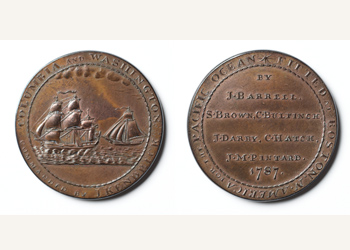Collections Online
Columbia and Washington medal
To order an image, navigate to the full
display and click "request this image"
on the blue toolbar.
-
Choose an alternate description of this item written for these projects:
- MHS Collecting History
- MHS 225th Anniversary
- Arctic-Heritage-Library
Inspired by the British Royal Society's medals commemorating explorer James Cook's voyages, Boston merchant Joseph Barrell commissioned the Columbia and Washington medal to be sent to the Pacific on the Columbia and Lady Washington in 1787. The bill of lading for the voyage lists 300 medals "to be distributed amongst the Natives on the North West Coast of America, and to commemorate the first American Adventure on the Pacific Ocean." Considered the first die-struck medal issued after American independence, the Columbia and Washington token received considerable attention in contemporary newspaper accounts.
In spite of this notoriety, the origin of the medal remains obscure. While Joseph Barrell probably was solely responsible for its production, neither he nor the newspapers thought to mention the designer, die-maker, or how many medals were struck in each metal used (pewter, copper, and silver). It once was thought that architect Charles Bulfinch was the only member of the partnership with the necessary skills to design the medal, but the jewelry that Joseph Barrell designed and had made for his family is proof of his artistic ability. Joseph Callender has been suggested as the die-maker for the Columbia and Washington medal. After apprenticing under Paul Revere, Callender went into business for himself in Boston as an engraver. One definite connection between Callender and the first voyage of the Columbia is the set of dies that he made for the new Massachusetts 1787 cents and half-cents; the Columbia partners obtained and shipped the new Massachusetts coinage before it was officially circulated.
In 1791, acting on behalf of the merchants involved in the voyage, Joseph Barrell presented this copper Columbia and Washington medal to the newly established Massachusetts Historical Society. It has long been treasured as the cornerstone of the Society's numismatic collection. The Society acquired a silver medal in 1905 and completed the set in 1962 with the Nash-Halsey pewter medal, inherited from James Briggs who built the Columbia.
For more information about our numismatic holdings, please see the Numismatics & Historical Artifacts section of our website.
The Boston-China Trade
At the close of the American Revolution, United States ships opened new trade routes to the East. No longer subject to the monopoly of the British East India Company, American merchants eagerly desired to trade with the East Indies, and with Canton, China in particular. While British merchants traded for Chinese goods with gold, Americans did not have the luxury of extra capital, and sought new commodities to trade with the Chinese for their teas, silks and other goods. In 1787, a group of Boston merchants decided there was profit to be made in trading sea otter furs from the Northwest Coast of America to the Chinese. The ship Columbia Rediviva and sloop Lady Washington set off in September of 1787 around Cape Horn to the Northwest Coast to trade with Native Americans for furs and then continued on to China. (See the online presentation of the title page of the manuscript log and narrative of this voyage by Robert Haswell.) This voyage established the highly profitable Boston-Northwest Coast-Canton trade, which made fortunes for many Boston merchants.
Hoping to trade furs with the Japanese as well, the Lady Washington continued onward from China to Japan in 1791 and those on board became the first American visitors to that country. While this initial trading was not a success, it was a first tiny crack in opening isolated Japan to the West and inaugurated more than two centuries of Japanese-American relations. It also established a relationship between Boston and Japan that would flourish in the 19th century and continue to this day.
Suggestions For Further Reading
Bentley, Anne E. "The Columbia-Washington Medal." Proceedings of the Massachusetts Historical Society, 101 (1989), p. 120-127.
Crossman, Carl L. The China Trade: Export Paintings, Furniture, Silver, and other Objects. Princeton, N.J.: Pyne Press, 1972.
Howay, Frederic W., ed. Voyages of the Columbia to the Northwest Coast 1787-1790 & 1790-1793. Portland, OR: Oregon Historical Society Press in cooperation with the Massachusetts Historical Society, c1990. (Originally published in 1941 as volume 79 of the Massachusetts Historical Society Collections.)
Morison, Samuel Eliot. The Maritime History of Massachusetts, 1783-1860. Boston: Northeastern University Press, 1997. (Originally published in 1921 by Houghton, Mifflin Company, Boston).
Witness to America's Past: Two Centuries of Collecting by the Massachusetts Historical Society. Boston: The Massachusetts Historical Society and the Museum of Fine Arts, 1991, p. 127-131.

